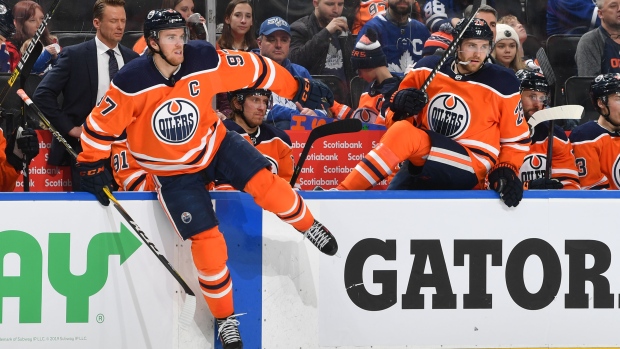Jan 7, 2021
Average defence enough to make Oilers contenders in North Division
Sharpening their defensive play across the board would turn the top half of Edmonton’s loaded lineup into a juggernaut, Travis Yost writes.
By Travis Yost

We expect a wild 56-game sprint in the all-Canadian division, alternatively known as the Scotia NHL North Division. If you believe the betting markets, it’s the Toronto Maple Leafs' division to lose.
The Maple Leafs may have the deepest roster in the division and seem like a playoff lock, but I’m not as convinced as the betting markets are (37 per cent implied probability) that they will end up on top.
It remains to be seen if their defensive issues – substandard off-puck play from the blueline, and a shaky Frederik Andersen season – have been sorted out. These same defensive issues made them indiscernible from the likes of the Winnipeg Jets and Vancouver Canucks in the standings last season – by win/loss record and goal differentials alike.
But if we have reservations about Toronto’s defensive prowess, then we have outright concerns about every other roster in the division. Finding a reason to disbelieve Toronto is just as hard as finding a reason to believe in another Canadian club.
The Canadiens are returning an abysmal power play. The Oilers goaltending situation is of concern. The Canucks had to purge some depth from a lineup that was getting just 48 per cent of expected goals in the first place. The Jets seem to enjoy making life difficult for Connor Hellebuyck. The Flames had to burn through valuable cap space in order to shore up an untenable goaltending situation. The Senators are clearly still rebuilding.
The one team I keep coming back to as the presumptive challenger is the Oilers, for two reasons. The first is that I thought the front office had a quality off-season, ensuring depth forward positions that have killed this club for years would be filled by the likes of Kyle Turris, Tyler Ennis, Jesse Puljujarvi, and Dominik Kahun.
The second is I suspect we haven’t seen anything close to the performance ceiling for Connor McDavid and Leon Draisaitl, and that is a terrifying thought.
How can that be said of two players who already have three Art Ross trophies and two Hart Memorial trophies, and are considered two of the most dangerous attackers the league has to offer? The short answer is because for as dominant as both of these guys have been, the hardware recognition has generally been for their offensive contributions (which have been otherworldly). But their net impact has been sharply marginalized, in large part because of woeful defensive numbers.
How much of this falls on Draisaitl and McDavid versus the blueline and goaltending is certainly up for debate, but it has sharply reduced their overall effectiveness. If we compare Edmonton’s super duo to other Canadian stars over the past couple of seasons, you can see the type of diminishing returns they are seeing:

Compared to a random sampling of other high-impact forwards around the all-Canadian division, two things stand out: Draisaitl and McDavid are magicians at generating in the offensive end, and based on their respective point totals, we know that they do the lion’s share of the heavy lifting when it comes to playmaking and goal scoring. It is quite fair to say that they carry a uniquely heavy burden to generate offence for their team, and they do so both at even strength and on the power play.
The second thing that stands out is just how much of their offensive production is marginalized because their opponents also can score at will. Compare McDavid and Draisaitl to Elias Pettersson in Vancouver. Pettersson isn’t as effective offensively, but the Canucks have been much more capable slowing offensive pressure than the Oilers in recent years. That’s why Pettersson has made Vancouver 0.7 goals better than their opponents every 60 minutes of play over the past two seasons; for McDavid and Draisaitl, it’s barely above break-even.
Pettersson, of course, has enjoyed playing with talented two-way defensive wingers and a sharp goaltender in the form of Jacob Markstrom. But this is the biggest reason why you are seeing quotes from McDavid in training camp about the importance of keeping pucks out of their net.
If the Oilers can sharpen their defensive play across the board it’s going to pay serious dividends in the standings, and we will ultimately end up rethinking how dangerous Edmonton’s top units are.
Even average defensive results would turn the top half of the Oilers lineup into a juggernaut, as opposed to a truly scary offensive team that’s going to give you those goals right back over the course of games.
To that end, if you are looking for one team to carry the baton as the Maple Leafs biggest challenger, you could do a lot worse than this Edmonton team.
Data via Natural Stat Trick, Evolving Hockey, NHL.com

